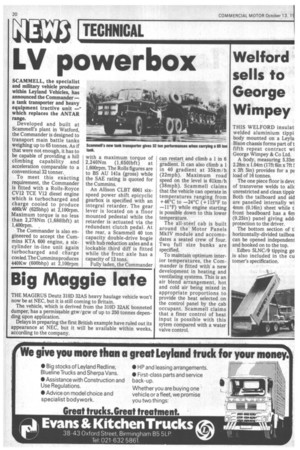LV powerbox
Page 22

If you've noticed an error in this article please click here to report it so we can fix it.
SCAMMELL, the specialist and military vehicle producer within Leyland Vehicles, has announced the Commander — a tank transporter and heavy equipment tractive unit -which replaces the ANTAR range.
Developed and built at Scammell's plant in Watford, the Commander is designed to transport main battle tanks weighing up to 65 tonnes. As if that were not enough, it has to be capable of providing a hill climbing capability and acceleration comparable to a conventional 32 tonner.
To meet this exacting requirement, the Commander is fitted with a Rolls-Royce CV12 ICE V12 diesel engine which is turbocharged and charge cooled to produce 466kW (625bhp) at 2,100rpm. Maximum torque is no less. than 2,278Nm (1,6801bft) at I ,40Orpm. , The Commander is also engineered to accept the Cummins KTA 600 engine, a sixcylinder in-line unit again turbocharged and charge cooled. The Cummins produces 440Kw (600bhp) at 2,100rpm with a maximum torque of 2,240Nm (1,6501bft) at 1,600rpm. The Rolls figures are to BS AU 141a (gross) while the SAE rating is quoted for the Cummins.
An Allison CLBT 6061 sixspeed power shift epicyclic gearbox is specified with an integral retarder. The gear lever is located on a floor mounted pedestal while the retarder is actuated via the redundant clutch pedal. At the rear, a Scammell 40 ton capacity double-drive bogie with hub reduction axles and a lockable third diff is fitted while the front axle has a capacity of 12 tons.
Fully laden, the Commander can restart and climb a 1 in 6 gradient. It can also climb a 1 in 40 gradient at 35km /h (22mph). Maximum road speed on the level is 61km/h (38mph). Scammell claims that the vehicle can operate in temperatures ranging from +46°C to —24°C ( +115°F to —11°F) while engine starting is possible down to this lower temperature.
The all-steel cab is built around the Motor Panels MkIV module and accomodates a seated crew of four. Two full size bunks are specified.
To maintain optimum interior temperatures, the Commander is fitted with a new development in heating and ventilating systems. This is an air blend arrangement, hot and cold air being mixed in appropriate proportions to provide the heat selected on the control panel by the cab occupant. Scammell claims that a finer control of heat input is possible with this sytem compared with a water valve control.
























































































































































































































